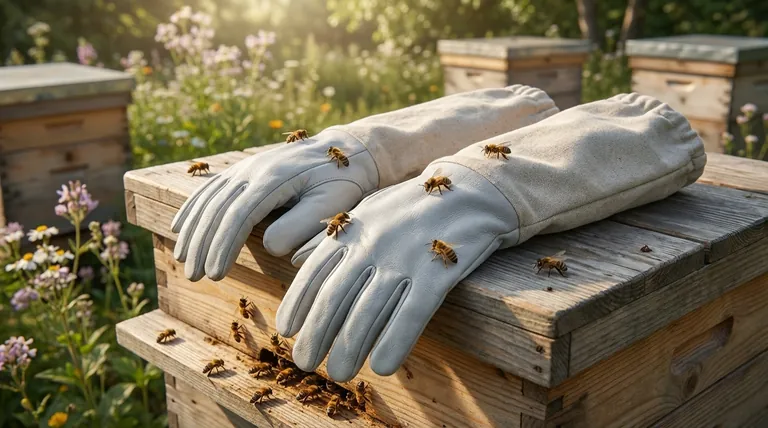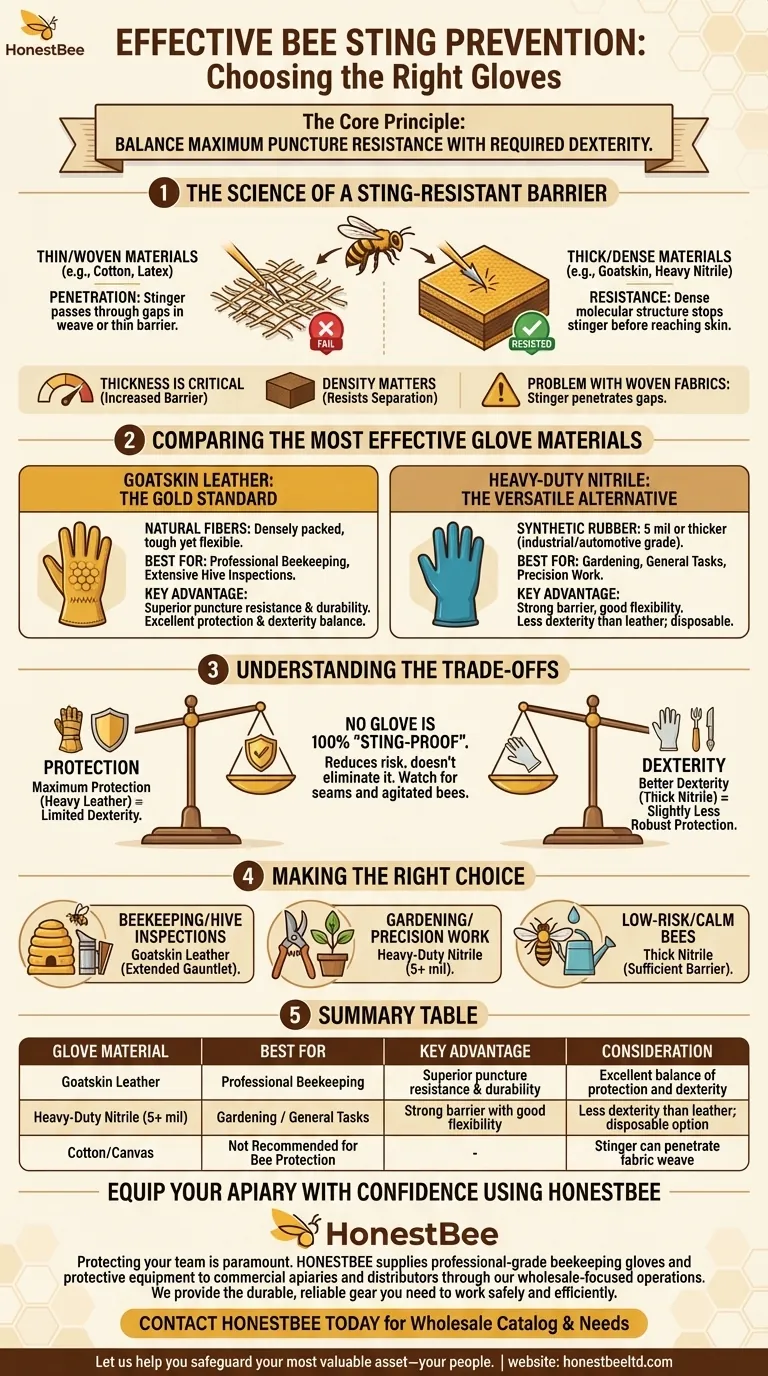For preventing bee stings, the most effective gloves are made from thick, puncture-resistant materials. Goatskin leather is the traditional and highly effective standard for beekeepers, while heavy-duty nitrile gloves offer a modern, disposable alternative that also provides excellent protection. These materials create a physical barrier that is difficult for a bee's stinger to penetrate.
The core principle for preventing bee stings is not just the material itself, but its thickness and density. Your goal is to choose a glove that balances maximum puncture resistance with the dexterity required for your specific task.

The Science of a Sting-Resistant Barrier
A bee's stinger is a sharp, barbed instrument designed to pierce skin. To stop it, a glove material must be tough enough to resist that initial puncture. This comes down to two key factors.
How Puncture Resistance Works
The effectiveness of a glove is its ability to withstand a sharp, pointed object. Materials like leather and thick nitrile have a dense molecular structure that a stinger cannot easily separate and push through.
Why Material Thickness is Crucial
A thicker barrier provides more material for a stinger to travel through, increasing the chance it will be stopped before it reaches your skin. This is why thin, disposable gloves, such as those made from latex, offer very little protection.
The Problem with Woven Fabrics
Gloves made of simple cotton or canvas can be deceiving. While they may feel thick, a bee's stinger is small enough to pass through the gaps in the fabric's weave, making them an unreliable choice for protection.
Comparing the Most Effective Glove Materials
While many materials exist, two stand out for their proven effectiveness in beekeeping and other outdoor work where bee encounters are common.
Goatskin Leather: The Gold Standard
Goatskin is the preferred material for professional beekeeping gloves. Its natural fibers are densely packed, creating a remarkably tough yet flexible barrier. It offers an excellent combination of protection and the tactile sensitivity needed for delicate hive work.
Heavy-Duty Nitrile: The Versatile Alternative
Nitrile, a type of synthetic rubber, can be highly effective when you choose the correct thickness. Look for industrial- or automotive-grade nitrile gloves, typically 5 mil or thicker. These provide a strong barrier that stingers struggle to pierce, but they offer less dexterity than leather.
Understanding the Trade-offs
Choosing the right glove is not just about finding the most protective option; it's about finding the right tool for the job. No glove is perfectly "sting-proof" in all situations.
Protection vs. Dexterity
This is the most significant trade-off. The thickest, most protective gloves, like heavy leather gauntlets, will limit your ability to feel and manipulate small objects. Lighter gloves, like thick nitrile, offer more dexterity but may provide slightly less robust protection against a determined bee.
The Myth of 100% "Sting-Proof"
Even the best gloves are not infallible. A highly agitated bee may be able to find a weak point, often along a seam, or deliver a sting that partially penetrates the material. The goal of protective gloves is to drastically reduce the risk of stings, not eliminate it with absolute certainty.
Making the Right Choice for Your Goal
Your specific task should dictate your choice of glove.
- If your primary focus is beekeeping or extensive hive inspections: Goatskin leather gloves, often with an extended gauntlet, provide the best combination of durable protection and necessary feel.
- If your primary focus is gardening or work where dexterity is key: Heavy-duty nitrile gloves (at least 5 mil thick) offer excellent protection while allowing you to handle tools and plants with greater precision.
- If your primary focus is a quick, low-risk task near calm bees: A thick nitrile glove is a sufficient and practical barrier for minimizing risk.
Ultimately, the right glove empowers you to work confidently and safely in the presence of bees.
Summary Table:
| Glove Material | Best For | Key Advantage | Consideration |
|---|---|---|---|
| Goatskin Leather | Professional Beekeeping | Superior puncture resistance & durability | Excellent balance of protection and dexterity |
| Heavy-Duty Nitrile (5+ mil) | Gardening / General Tasks | Strong barrier with good flexibility | Less dexterity than leather; disposable option |
| Cotton/Canvas | Not Recommended for Bee Protection | - | Stinger can penetrate fabric weave |
Equip Your Apiary with Confidence Using HONESTBEE
Protecting your team is paramount. HONESTBEE supplies professional-grade beekeeping gloves and protective equipment to commercial apiaries and distributors through our wholesale-focused operations. We provide the durable, reliable gear you need to work safely and efficiently.
Let us help you safeguard your most valuable asset—your people.
Contact HONESTBEE today to discuss your equipment needs and request a wholesale catalog.
Visual Guide

Related Products
- Goat Skin Leather Bee Sting Proof Beekeeping Gloves with Canvas Sleeve
- Goatskin Leather Beekeeper Gloves with Vent Long Sleeve for Beekeeping Honey Bee Sting Proof Protection
- Beekeeping Gloves Goatskin Leather with Long Cotton Sleeve for Beekeepers
- Mesh Ventilated 3 Layer Goatskin Beekeepers Gloves for Beekeeping
- Professional Galvanized Hive Strap with Secure Locking Buckle for Beekeeping
People Also Ask
- What are the pros and cons of leather beekeeping gloves? Maximize Protection or Dexterity
- What makes polyurethane foam environmentally friendly? The Surprising Benefits of a Durable, Inert Material
- What should beginner beekeepers consider when choosing beekeeping gloves? Balance Protection and Dexterity for Success
- What are some expert tips for cleaning beekeeping gloves? Extend Glove Life & Protect Hive Health
- What are the steps to clean goat leather beekeeping gloves? A Guide to Extend Gear Life



















